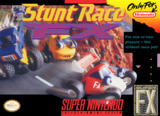Stunt Race FX pushes the envelope for polygonal graphics on the SNES, and is a very well-designed racer.
There's only so many ways you can do a standard racing game, and Stunt Race FX (or Wild Trax as it's known in Japan) opts for adding allotted time each time you pass through a checkpoint. The racing portion of the game itself consists of three classes of four races each, plus a bonus level after the second race to accumulate extra allotted time. Only three other competitors are on the track at any time, likely a result of the technical limits already being pushed. In all, on the surface, things are pretty standard.
Two aspects of the races really stand out, however. The first would be the four vehicles that you can race as. As with many other games, each has their own strengths and weaknesses. With Stunt Race FX, the differences are so pronounced that it almost feels like a whole new game with each of the vehicles. One is very sturdy with good acceleration, but with weak handling and a slow top speed. Another is fast and agile but fragile and with poor acceleration and boost meter usage (replenished by picking up blue gems on the course). The vehicle with the best stats is a motorcycle, but the lack of wheels makes it very unstable. Mastering this vehicle is totally dependent upon keeping your balance at all times. If you do you'll set course records; if not you'll wobble back and forth along the track and crash into walls. And to add some personality, the cars themselves are alive. While having no real impact on gameplay, it's neat seeing a car push off a wall with its wheels/hands when it gets too close, or the animation of a car breaking sometimes being similar to that of an animal.
The other aspect is the tracks themselves. Needless to say, after every console racer prior being on a 2D course, the addition of hills and jumps and the like certainly changes things a lot. Many of the courses have an interesting twist of ramps, bridges, tunnels, and bumps. Some tracks even have halfpipes to carefully negotiate across. For being such an early 3D game, the physics engine is rather impressive, perhaps even better than some racers from the following generation of games on much more powerful hardware. There are even occasional obstacles that appear as the race goes on, like a boulder falling onto the track in a desert canyon.
There are more than just the twelve races, though. There are the three short bonus levels, in which you control a tractor-trailer through some gates. The handling and the camera controls are extremely unwieldy in this stage, likely intentionally, in order to add a decent amount of challenge and variety to the courses. There are four stunt tracks, in which you negotiate a bumpy obstacle course to collect as many star balloons as possible in order to finish before the timer runs out. These stunt tracks are perhaps the best use of the 3D engine in the game, as many of them are littered with craters, jumps, halfpipes, and banked turns. Also unlockable are four small demolition derby type areas, where you control a car from a radio-controlled perspective above the course and attempt to ram into the other three competitors as quickly as possible. Sadly, though, the two-player mode leaves a lot to be desired. There are four tracks, all very simple compared to the rest of the tracks, and each window of the split screen taking up less than a quarter of the screen. If you want some good split screen racing action, you'll have to find another racing game to fill your needs.
The graphics of the game are a major leap over those found in Star Fox. While Star Fox was able to fall upon giant black backgrounds for much of the game, Stunt Race FX had to create an actual fully rendered world for each track. There are nice vivid colors across all the themed raceways, from desert canyons, city highways, a misty forest, or a snowy raceway. On top of all of this, the tracks are not static. The fog will lift by the final lap of the forest race, the sky may change towards an orange sunset, a plane might fly by a city highway, or a short downpour may begin. The only real problems are the occasional clipping issue near a wall, or the size of some of the polygons since there were so many being drawn on a screen. The track up a hill can be all one polygon, with the same exact color. It's entirely understandable, but it can sometimes stand out against the more-detailed car models. Similarly, the audio is also done very well. The music for a lot of the tracks are very upbeat and match well with the location, from the ominous tune during a desert thunderstorm to a whimsical track during a race in the clouds. The sound effects are also of high quality, from plane flybys to a pack of coyotes crossing a track to the sounds of the engines.
Often overlooked relative to its more famous FX predecessor, Stunt Race FX provides a very entertaining racing game that broke some new ground on consoles. From its interesting courses and unique vehicles to its interesting stunt racing concept, Stunt Race FX did a remarkable job for such a very early attempt at 3D racing. While its impact may not be as apparent a decade later, the fact that it is just as entertaining so many years later is a testament to its great design.

